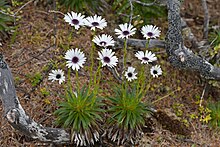Damnamenia
| Black-eyed daisy | |
|---|---|

| |
| Damnamenia vernicosa growing on Campbell Island | |
| Scientific classification | |
| Kingdom: | Plantae |
| Clade: | Tracheophytes |
| Clade: | Angiosperms |
| Clade: | Eudicots |
| Clade: | Asterids |
| Order: | Asterales |
| Family: | Asteraceae |
| Subfamily: | Asteroideae |
| Tribe: | Astereae |
| Subtribe: | Celmisiinae |
| Genus: | Damnamenia Given |
| Species: | D. vernicosa
|
| Binomial name | |
| Damnamenia vernicosa (Hook.f.) Given
| |
| Synonyms[2] | |
| |
Damnamenia is a genus of flowering plants in the family Asteraceae.[3][4][5][6][7]
The only known species is Damnamenia vernicosa, called the black-eyed daisy. It is endemic to New Zealand (Auckland and Campbell Islands).[2][8]
Description
[edit]Damnamenia vernicosa is a small, perennial, stoloniferous herb. It has glossy green leaves and white daisy flowers with dark purple centres. The plant flowers from November to January and fruits from December to March.[9]
Distribution and habitat
[edit]The plant is endemic to New Zealand's subantarctic Auckland and Campbell Islands. Its preferred habitats are upland cushion bogs and Pleurophyllum-dominated herbfields. It also grows at lower elevations in exposed and sparsely vegetated sites.[9]
Taxonomy & naming
[edit]It was first described in 1844 as Celmisia vernicosa by Joseph Hooker.[10] In 2012, David Given separated C. vernicosa from Celmisia and from related genera on the basis of its morphology, and allocated it to the new genus, Damnamenia. Given named the genus Damnamenia for the Dactyl, Damnamenius, since Celmisia was named for Celmis, another Dactyl.[3] The specific epithet, vernicosa, is the Latin adjective, vernicosus,-a, -um, meaning "varnished",[11] and refers to the apparently varnished leaves.[10]
Conservation status
[edit]The species is listed as "At Risk – Naturally Uncommon" on the most recent (2018) New Zealand Threatened Classification for plants, because of its restricted range).[1]
Gallery
[edit]-
Damnamenia vernicosa growing among other flora on Campbell Island
-
Damnamenia vernicosa growing on a cliff face on Campbell Island
-
Close-up of a Damnamenia vernicosa flower
References
[edit]- ^ a b Lange, Peter J. de; Rolfe, Jeremy R.; Barkla, John W.; Courtney, Shannel P.; Champion, Paul D.; Perrie, Leon R.; Beadel, Sarah M.; Ford, Kerry A.; Breitwieser, Ilse; Schönberger, Ines; Hindmarsh-Walls, Rowan (May 2018). "Conservation status of New Zealand indigenous vascular plants, 2017" (PDF). New Zealand Threat Classification Series. 22: 42. OCLC 1041649797.
- ^ a b "Flann, C (ed) 2009+ Global Compositae Checklist". Archived from the original on 16 November 2014. Retrieved 16 November 2014.
- ^ a b Given, David R. (2012). "Damnamenia gen. nov. A new subantarctic genus allied to Celmisia Casso (Astereae—Compositae)". New Zealand Journal of Botany. 11 (4): 786–787. doi:10.1080/0028825X.1973.10430310. ISSN 0028-825X. pdf
- ^ Botanic Garden and Botanical Museum Berlin-Dahlem. "Details for: Astereae". Euro+Med PlantBase. Freie Universität Berlin. Retrieved 18 July 2009.
- ^ UniProt. "Tribe Astereae". Retrieved 18 July 2009.
- ^ National Herbarium of New South Wales. "Genus Kippistia". New South Wales FloraOnline. Royal Botanic Gardens, Sydney. Retrieved 18 July 2009.
- ^ "Polyarrhena Cass". African Plants Database. South African National Biodiversity Institute, the Conservatoire et Jardin botaniques de la Ville de Genève and Tela Botanica. Retrieved 18 July 2009.
- ^ Living National Treasures, Checklist of Endemic Vascular Plant Genera, New Zealand
- ^ a b "Damnamenia vernicosa". New Zealand Plant Conservation Network. 30 October 2013. Retrieved 6 July 2014.
- ^ a b Hooker, J.D. (1844) The botany of the Antarctic voyage of H.M. discovery ships Erebus and Terror in the Years 1839-1843 :under the command of Captain Sir James Clark Ross: 1: 34
- ^ Stearn, W.T. (2004). Botanical Latin (4th ed). Oregon: Timber Press. p. 527. ISBN 9780881926279.
- ^ Hooker, J.D. (1852) The botany of the Antarctic voyage of H.M. discovery ships Erebus and Terror in the Years 1839-1843 :under the command of Captain Sir James Clark Ross: 1: Plates XXVI-XXVII


![Damnamenia vernicosa as Celmisia vernicosa (Plates XXVI-XXVII Fitch)[12]](http://upload.wikimedia.org/wikipedia/commons/thumb/b/b7/Flora_Antarctica_Plate_XXVI.XXVII.jpg/72px-Flora_Antarctica_Plate_XXVI.XXVII.jpg)


